Mansfield Zoo


Mansfield Zoo is one of North East Victoria's hidden secrets, with a large collection of exotic and native animals on 30 acres of picturesque parkland featuring lovely views across the Delatite Valley to Mt Buller.
Hand feed many of the animals as you wander! You can hand feed deer, kangaroos, emus and llamas. Meet Sophia and Miss Greedy, our friendly fallow deer, and Joey the Grey Kangaroo, just some of the animals who will interact with you as you stroll around.
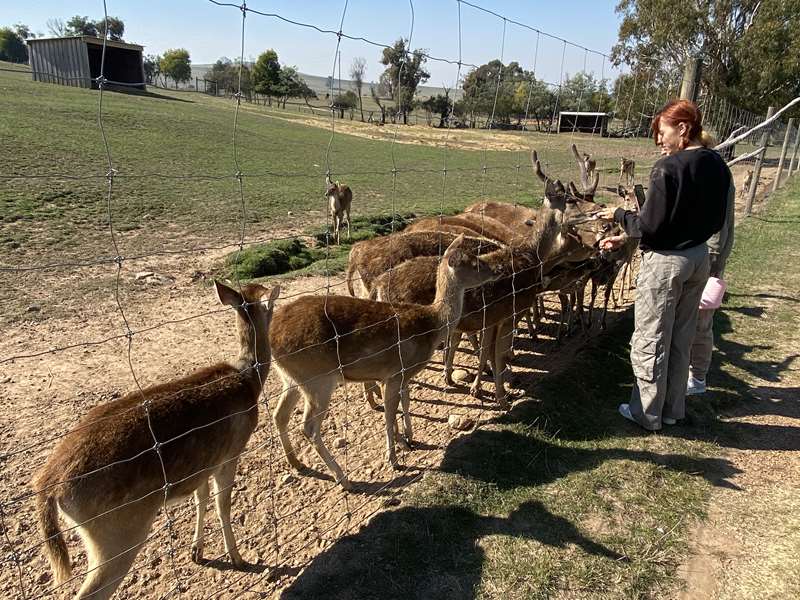
Bring along family, friends and a picnic lunch, or sample local wine and fare in our licensed cafe. For those who are more adventurous, stay overnight in a swag and fall asleep to the roar of the lions!
Exotic animals include African Lions, Monkeys, Bison, Blackbuck Antelope, Himilayan Tahr, Alligator, Ostrich, Polecats, Maned Wolves, Camels, Rusa Deer, Red Deer, White Fallow Deer, Llama. Native Animals include Wombats, Dingos, White Kangaroos, Agile Wallabies, Swamp Wallabies, Emus, Sulphur Crested Cockatoo, Grey Kangaroos, Cape Barren Goose, Galah and Spotted Quoll.
There is an undercover BBQ facility which is free to use. There are also picnic tables and other undercover areas around the zoo in the event of inclement or hot weather.
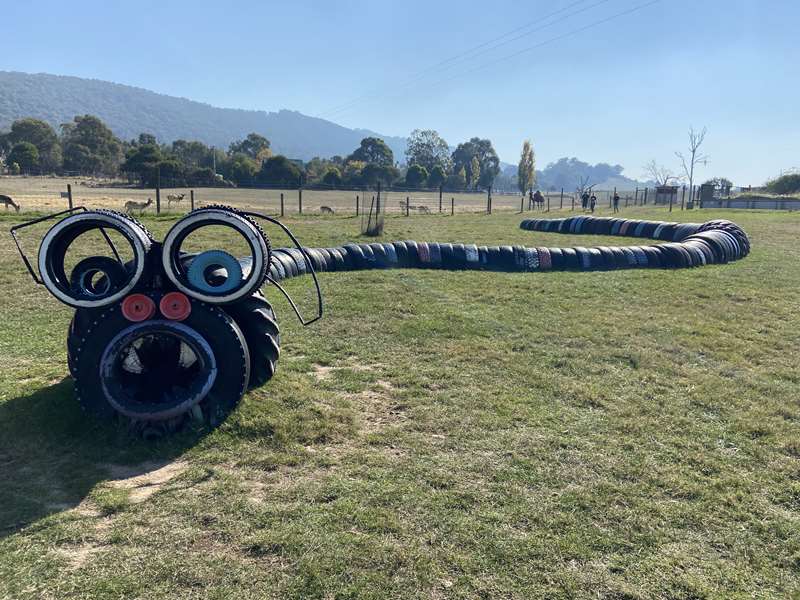
Opening Hours:
Opening Hours and Feeding Times
Cost:
Entry Prices
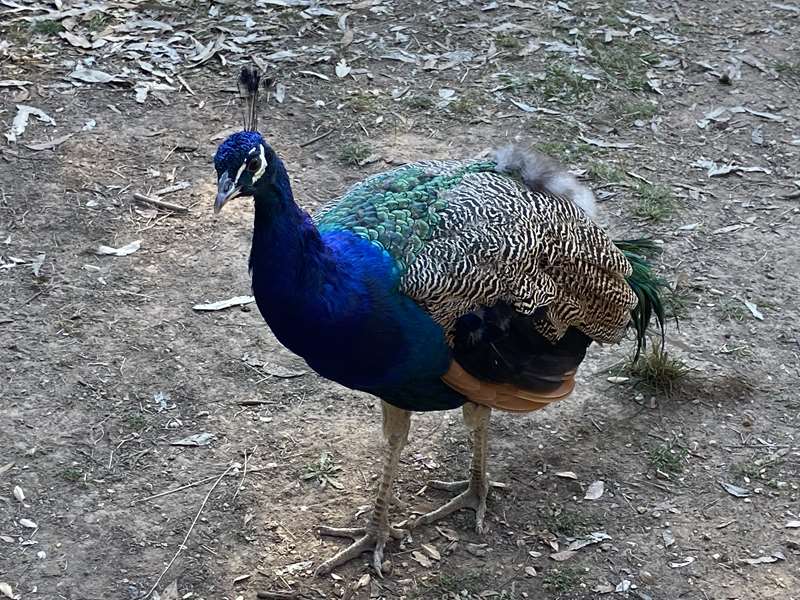
Meerkat
Suricata suricatta
Height: 25-35cm (+tail), Weight: 720-730g
Meerkats are a small omnivore of the mongoose family found through the Kalahari and Namib Deserts of Southern Africa where temperatures range from below freezing to over 40C. They dig multi-chamber, complex burrows that can be over 2.4m deep. Meerkats can close their ears when digging to keep out sand and dirt. In the wild, Meerkats live up to 10 years and in captivity for 12-15 years. They eat insects, eggs, fruit and plants. Females typically give birth to 2 - 4 young, but can have as many as 8. Babies are cared for by the whole mob.
White-fronted Capuchin
Cebus albifrons
Height: 84cm, Weight: 2.9 - 3.4kg
White fronted capuchins are a New World monkey found throughout much of South America. They are a medium sized monkey known for their intelligence and are one of the few primates observed making and using tools. They are well recognised for their use in film work. In the wild they live for 12-20 years and in captivity up to 30 years. They are omnivorous and eat a range of fruits, insects, vertebrates and bird's eggs. Their favourite food are eggs and any very sweet fruits. Females give birth to a single young.
Common Wombat
Vombatus ursinus
Length: 88-110m, Weight: 35 - 65kg
One of three species of wombat, the Common Wombat is found throughout much of Southern and Eastern Australia. They prefer damp forest areas where they dig extensive burrow systems with their rodent like teeth and sharp claws. They are a marsupial and the females have a large backward opening pouch - an adaptation to prevent soil from entering. They give birth to one Joey.
In the wild they live for 12-15 years and in captivity up to 30 years. Wombats are herbivores and eat a range of grasses, herbs, sedges, bark, and roots.
Dingo
Canus lupus dingo
Length: 120cm, tail length: 38cm, height: 44-63cm, weight: 10-24kg
The Dingo is believed to be a descendant of the Indian wolf (Canis lupus pallipes). They arrived in Australia about 6000 years ago and are now found throughout the mainland. They are most commonly ginger, although black, white or tan animals are also found. White markings on the feet, tail tip and chest are also common. Dingos rarely bark but occasionally emit short yaps or long, piercing howls. Dingos are protected in captivity when kept as pets or in wildlife parks, but are hunted in the wild.
Llama
Llama glama
Height: 1.7-1.8m, weight: 130-200kg
Llama and Alpaca evolved from the camel family, and originated in the Andes Mountains of South America. Llama, Alpaca and Camel belong to the genetic family Camelidae and are thus known as Camelids. They are known to spit over disputes about food, and to warn off unwanted advances. Llama's are a much bigger animal than Alpaca, and are widely used for clothing, food, companionship and transport. They are herbivores and eat a range of grasses and leaves. Females give birth to one young, called a cria, each year, after an 11 1/2 month gestation. Multiple births are virtually unheard of. Life expectancy is 15 - 20 years.
Llama originated in the central plains of North America about 40 million years ago. They migrated to South America during the last ice age, where they were domesticated and used as pack animals by the Incas.
Emu
Dromaius novaehollandiae
Height: 1.8m, weight: 36-40kg
Emu are a large, soft-feathered, brown flightless bird, found over most of mainland Australia. They are the second largest bird in the world, after the ostrich, and can sprint up to 50kmph for short distances.
Emu's have unique double plume feathers, each one having two soft downy feathers from the one quill.
The female lays between 5 and 15 large green eggs, weighing 450-650g each. The male builds the nest and incubates the eggs, then nurtures the young while the female may continue to breed with other males.
Eastern Grey Kangaroo
Macropus giganteus
Length: MALE 2m FEMALE 1.1m, weight: MALE 66kg FEMALE 40kg
The Eastern Grey is found in southern and eastern Australia and is the most prevalent of the kangaroos, with a population estimated to be around 2 million. Like all kangaroos, the Eastern grey is mainly nocturnal and crepuscular and is mostly seen early in the morning, or as the light starts to fade in the evening. Like other kangaroos, the mother (doe) can produce two different kinds of milk simultaneously for differently aged joeys. Does are usually permanently pregnant, except for the day she gives birth.
African Lion - White
Panthera leo
Length: 1.8 - 2.5m, weight: 190-250kg
White lions occur naturally in just one area of South East Africa called Timbavati. They are now technically extinct, as no wild ones are known of, but a tawny lioness may still give birth to a white lion in that region.
Their unique colouring is caused by a genetic condition caused leucism, which gives them the light coat and blue eyes. It is not albinism, which would produce red eyes. Their coat colour can be very white through cream. Unlike most white animals, their coat color is no disadvantage in the wild as they are the apex predator.
African Lion
Panthera leo
Length: 1.4 - 2.5m, weight: 150-250kg
Lions once roamed all through Eurasia, Africa and the Americas. Aside from a small population of Asiatic Lions in India's Gir Forest, lions are now found only in Africa.
Lions live in a pride with 15 - 30 lions, lionesses and cubs. Both social order and hunting is controlled by the lionesses. Ousted male lions often form bachelor prides and scavenge or steal food rather than hunt.
Male lions have magnificent manes which make them appear larger to their rivals and help protect their neck when they fight other males for dominance of the pride.
Swamp Wallaby
Wallabia bicolour
Height: MALE 75cm FEMALE 66.5cm, weight: MALE 17kg FEMALE 13kg
It naturally prefers wet or dry sclerophyll forests, where it shelters in long dense grasses. Births occur between May and August and sexual maturity is reached at about 15 months. In the wild they prefer to browse on ferns, leaves, rushes etc rather than grazing on grasses.
Agile Wallaby
Macropus agilis
Height: MALE 1.5m FEMALE 1.2m, weight: MALE 35-45kg FEMALE 20-30kg
Found throughout Northern Australia and New Guinea, it is also known as the Sandy Wallaby for its light sandy colouring and pale underbelly. They also have a distinctive white face stripe from the lip to under the eye and a white strip along the thigh. They are the most common wallaby in Australia's northern areas. This social wallaby lives in groups up to 10 individuals, with several groups grazing together where feed is plentiful. They like to graze on grasslands and are known to dig up to 30cm deep for roots.
Rufous Bettong
Aepyprymnus rufescens
Length: 70 - 80cm, weight: 2 - 2.8kg
Rufous Bettong are the largest of the macropod marsupials known as the Rat-Kangaroo. They are about the size of a rabbit and hop like a small kangaroo. They are native to the coastal region of northern NSW. Rufous Bettong dig shallow burrows in the ground and cover them with piled up dried grass, twigs and leaves. Like other macropods, females may have up to three young at different stages of development at one time: an embryo, a joey in the pouch and a joey out of the pouch. She makes different milk for each suckling joey.
Camel
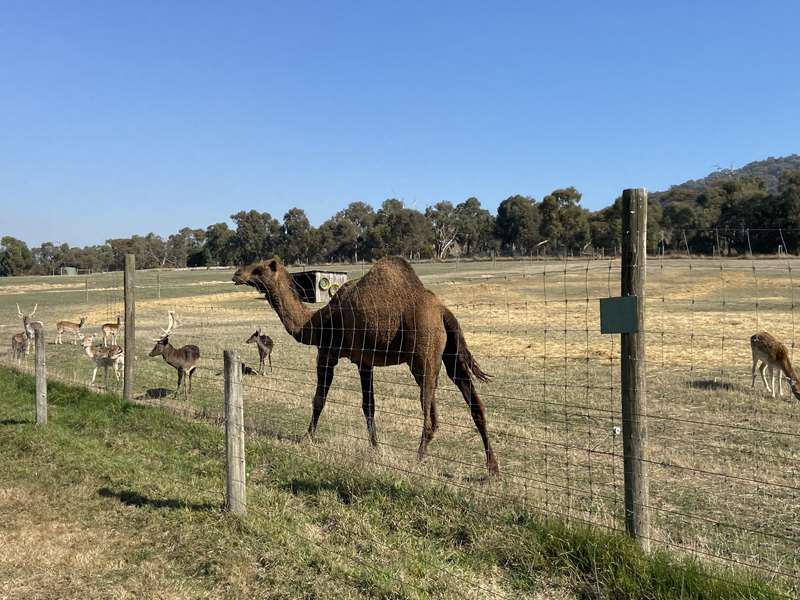
Camelus dromedarius
Height: MALE 90cm FEMALE: 76cm, weight: MALE 90kg FEMALE: 40-45kg
The single humped Arabian camel, or dromedary, is a native of Western Asia, and was imported into Central Australia between 1840 and 1907 to open up these arid areas for exploration and construction of rail and telegraph lines. In the 1920s there were an estimated 20,000 domesticated camels, but by 1930, with the advent of rail and motor transport, they were no longer needed and many were abandoned. Those now feral camels bred prolifically, and many are exported back to desert regions of Asia to rejuvenate herds there.
Rhesus Macaque
The Rhesus originates from India where it is found living up to 9 thousand feet above sea level. For this reason they adapt well to captivity in cooler climates. The female has a single young each year. They feed on fruit, plants, insects and small mammals.
Sambar Deer
Rusa unicolor
Height: 1.2-1.6m, weight: 225-320kg
Sambar deer are native through the Asian islands to India. They were introduced to Australia in the 1800's, and despite originating in warmer climates, have flourished in the Australian Alpine regions. Population estimates in Australia range into the 10's of thousands. Sambar are noted for their long frill of course hair around their neck, and their unusually long tail, both of which stand up when the animal is alarmed. Sambar are a close relative of the smaller Rusa deer and the two can interbreed. Sambar have rusine antlers, which typically have only three tynes.
Hog Deer
Axis porcinus
Height: 51-70cm, weight: 30-50kg
Hog deer are found in the wild from Indonesia to Pakistan. They are one of the smallest deer and derive their name for the way they run with head hung low to duck under obstacles rather than jump over them.
Unlike other deer, they do not have a herd structure. Males breed with single females at a time, rather than creating and maintaining a herd. When alarmed they make a short bark or whistle and nearby animals will dart in all directions rather than flee as a herd. They are herbivores and eat grasses, leaves and bark.
Brushtail Possum
Trichosurus vulpecula
Length: 550mm, weight: 1.5-2.5kg
This possum is a nocturnal, semi-arboreal marsupial found in most parts of Australia. It is the largest of the possums, about the size of a cat, with a pointy snout, a pink nose and long whiskers. There are four colour variations: Silver Grey, Brown, Black and Gold. They can stand upright on their hind legs.
The tail is prehensile (naked on the underside) and assists the sharp claws in climbing trees. During the day they sleep in a den in a hollow tree. Favourite foods are fruit and rose buds, and they have been known to eat small mammals such as rats.
Guinea Pig
Cavia porcellus
Length: 20 - 25cm, weight: 0.7 - 1.2kg
The Guinea pig is a species of rodent originating in the Andean Mountains of South America. They were domesticated around 5000BC and spread worldwide through trade once the Americas were discovered. They became an exotic pet for European Upper Class and Royalty, including Queen Elizabeth I, in the 1500's. Origins of their name are unclear as they are not a pig and not from the African country of Guinea. They can learn complex pathways to food and accurately remember learned paths for months.
Common Marmoset

Callithrix jacchus
Height: 18-19cm, weight: 240-260g
Common marmosets are a New World monkey found through the scrub forests and humid Atlantic forests of North Eastern Brazil. It is one of the smallest species of monkey and gained its name from the French word, marmouset, which means dwarf, or little.
In the wild they live for 12 years and in captivity up to 16 years. They eat a range of fruits and insects. Their favourite food is the sap of the acacia tree. Unlike most monkeys, they have modified claws rather than nails and females typically give birth to twins.
Texas Longhorns
Bos taurus
Horn Length - Bull: Up to 1.8m, Horn Length - Steer or Cow: Up to 2.1m
Texas Longhorns are a robust breed of cattle with characteristically long horns. They are descendants of the original cattle brought to the New World (America) by Christopher Columbus and the Spanish colonists.
They were the most frequent cattle used by the early ranchers, but when barbed wire put an end to free-roaming, the Texas Longhorns became close to extinction. By 1920, there were only a few hundred left. Rediscovered for their longevity and resistance to disease, these colourful animals are thriving once more.
Review:
The zoo, which is good value for money, is best suited to a leisurely stroll around while feeding the numerous animals which are more than eager for some food. There are lots of animals and birds roaming about the park including Fallow deer, Sambar deer, Alpaca, Eastern Grey Kangaroo, Guinea Fowl, Peacocks, ducks, guinea pigs and various visiting Australian wild birds. We would consider this more like an Animal Sanctuary than a zoo.
The following animals can be fed pellets placed on the hand or a spade (which is provided): kangaroos, deers loose in the park, emu, wallabies, alpaca/llama, guines pigs and birds loose in the park. Camels and deers in enclosures can be fed but only on a spade since they may bite or scratch. Obviously hand feeding the lions is not an option.
Unfortunately zookeeper animal feeding is only held on the weekend and Victorian Public and School Holidays which means that visitors outside this time can't experience lion and meerkat feeding.
The zoo is rather quirky with lots of fun metal sculptures made from recycled items.
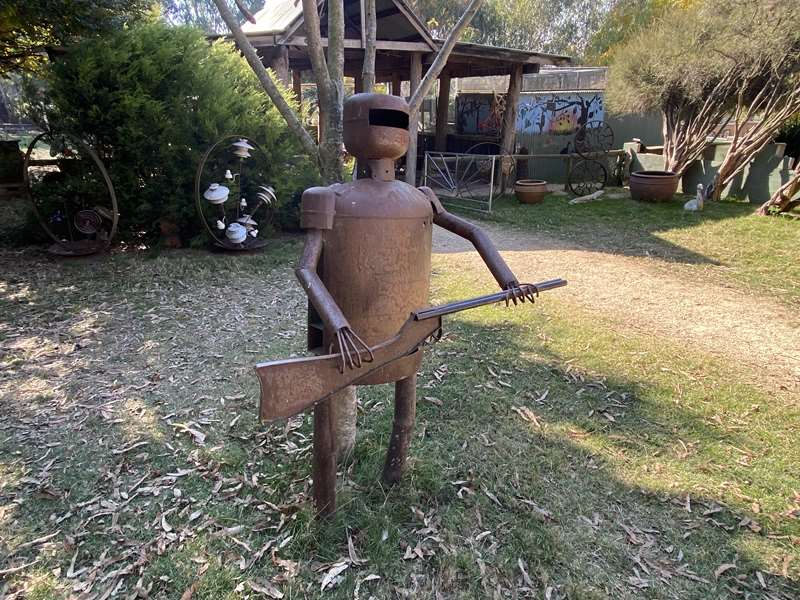

You are permitted to bring your own food and drinks and there are picnic tables. Near the entrance is a tram where you can sit.
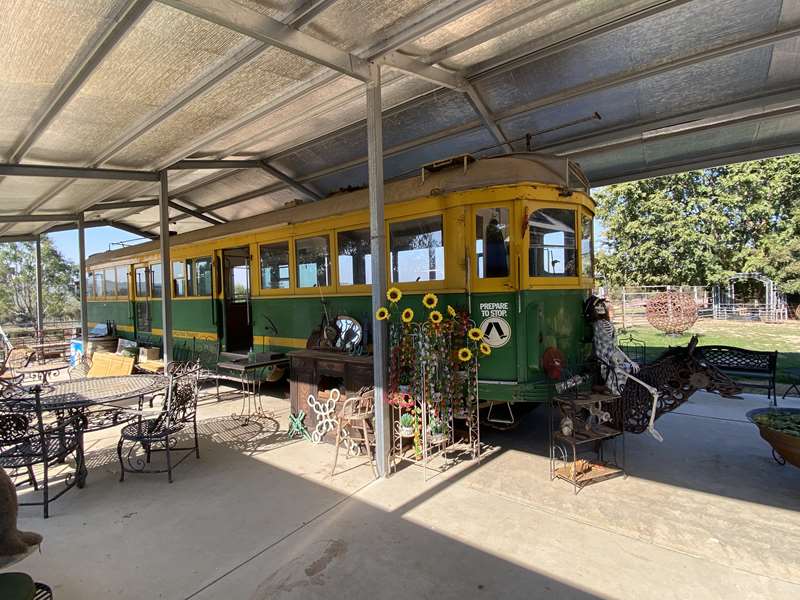
In some areas the grass is intentionally left long for the animals, so some care needs to be taken in summer with respect to snakes.
We really feel that the zoo would be better without the lions and monkeys which are in rather small enclosures.
Photos:
Location
1064 Mansfield-Wood Point Road, Mansfield 3722 View Map
✆ (03) 5777 3576
Email Enquiry
Web Links
→ www.mansfieldzoo.com.au
→ Mansfield Zoo on Facebook









